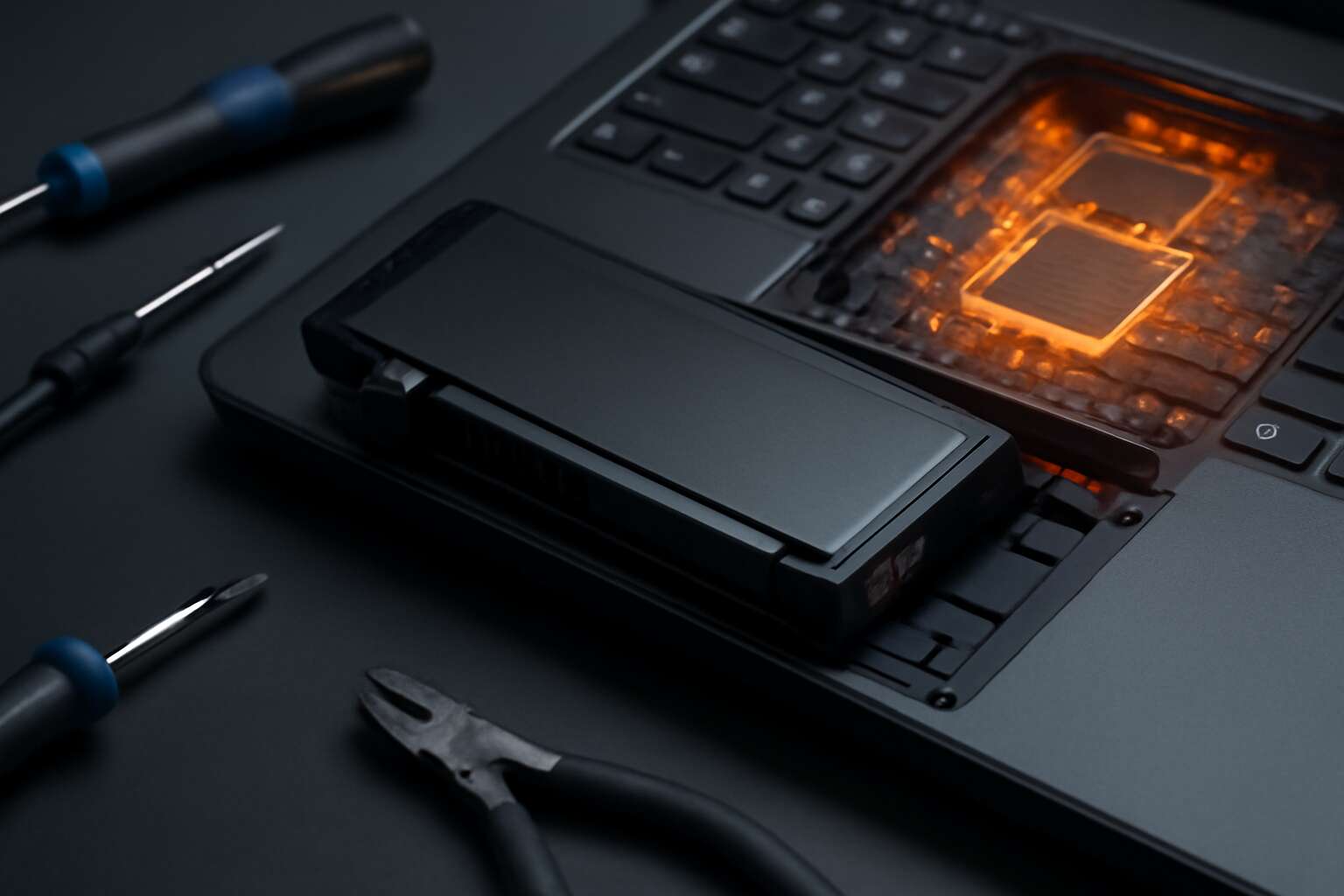Understanding Laptop Batteries
What Is a Laptop Battery?
Understanding laptop batteries reveals a fascinating blend of chemistry and engineering. A typical laptop battery is made of several key components that work together to power your device efficiently. The core element is the rechargeable lithium-ion cell, renowned for its high energy density and longevity. This cell is composed of a cathode, an anode, and an electrolyte, all carefully designed to facilitate the flow of ions during charging and discharging cycles.
What is a laptop battery? It’s essentially a compact energy reservoir that transforms chemical energy into electrical power. The materials used in its construction determine not only the battery’s capacity but also its lifespan and safety profile. To understand what makes a laptop battery reliable or prone to failure, it’s crucial to recognise the materials involved. The laptop battery is made of a combination of metals, plastics, and electrolytes, all engineered to ensure optimal performance and safety during everyday use.
Types of Laptop Batteries
Understanding the different types of laptop batteries reveals a fascinating evolution driven by technological innovation and environmental consciousness. While the core concept remains the conversion of chemical energy into electrical power, the materials used in each type influence performance, lifespan, and safety. The laptop battery is made of specific chemistries that cater to diverse needs—ranging from lightweight portability to high-capacity demands.
Among the most common variants is the lithium-ion battery, celebrated for its high energy density and long cycle life. These batteries are composed of a cathode, an anode, and an electrolyte, all carefully formulated to optimise ion flow during charge and discharge. Another prevalent type is the lithium-polymer battery, which offers greater flexibility in design and a slimmer profile, making it ideal for ultrabooks and sleek devices.
- Nickel-metal hydride (NiMH): An older technology offering reliability but lesser energy density.
- Nickel-cadmium (NiCad): Known for durability but less environmentally friendly due to toxic materials.
Ultimately, the materials that form the core of the laptop battery is made of directly influence its efficiency and safety. As manufacturers continue to innovate, new chemistries emerge, promising even more sustainable and powerful options for tomorrow’s devices. The intricate dance of metals, plastics, and electrolytes shapes the future of portable computing, reminding us of the profound complexity behind something as seemingly simple as a laptop battery.
Importance of Battery Composition
In the realm of portable power, the composition of a laptop battery is nothing short of alchemy—an intricate dance of elements and materials that determine its vitality and longevity. The **laptop battery is made of** a carefully balanced mixture of chemistries designed to unlock maximum energy whilst maintaining safety. Each element within these chemistries acts as a vital thread in the tapestry of performance, dictating how seamlessly your device operates and how long it endures between charges.
Understanding what the **laptop battery is made of** unveils the marvels behind its incredible capabilities. For instance, lithium-ion batteries, renowned for their high energy density, contain a cathode, an anode, and an electrolyte—each precisely engineered to optimise ion flow. These components come together in a symphony of chemistry, ensuring power delivery remains consistent over hundreds of cycles. Meanwhile, other chemistries, such as nickel-metal hydride or nickel-cadmium, showcase different characteristics, offering reliability and durability in their own right.
Ultimately, the materials that form the core of the **laptop battery is made of** are the silent architects of your device’s efficiency and safety. As technology advances, innovations in battery chemistry promise even more sustainable, lightweight, and powerful options—fueling the future of portable computing with a blend of science and artistry.
Components of a Laptop Battery
Electrode Materials – Array
In the shadowed corridors of technology, the essence of a laptop battery is woven from enigmatic materials that dance between science and sorcery. The core of this dark marvel, the electrode materials, are the heartbeat of its power. These components are crafted from intricate layers of lithium, graphite, and various metal oxides—each chosen for their unique ability to store and release energy with haunting precision.
Within the depths of the battery, the electrodes—specifically the anode and cathode—serve as the gatekeepers of electrochemical magic. The anode often whispers secrets in the form of graphite, while the cathode wears a cloak of metal oxides like lithium cobalt oxide or nickel manganese cobalt. These materials are the conduits of energy, forging pathways for electrons to traverse, igniting the device with spectral vitality.
To understand the composition of a laptop battery is made of, consider this array of electrode materials that shape its spectral life-force:
- Graphite (for the anode)
- Lithium Cobalt Oxide (for the cathode)
- Lithium Manganese Oxide
- Lithium Nickel Manganese Cobalt Oxide
Each element, each compound, is a fragment of the mysterious alchemy behind the power that sustains our digital existence. The labyrinth of electrode materials is where science meets the arcane, giving life to the silent, unseen force that fuels our modern shadows.
Electrolyte Composition
Behind every silent-powered laptop lies a complex cocktail of chemicals and compounds, all working in harmony to keep your device alive and kicking. The laptop battery is made of a carefully balanced electrolyte composition, which acts as the conductive bridge between the electrodes. This electrolyte isn’t just a random soup; it’s a sophisticated blend designed to facilitate the smooth flow of ions, ensuring your battery’s longevity and efficiency.
Most commonly, the electrolyte in a laptop battery is a liquid or gel containing lithium salts dissolved in an organic solvent. This setup allows for rapid ion transfer, which translates into quick charging times and decent power retention. The typical electrolyte includes:
- Lithium hexafluorophosphate (LiPF6) – the star performer enabling high energy density
- Organic carbonates like ethylene carbonate and dimethyl carbonate – acting as the solvent base
- Trace amounts of additives to enhance stability and safety
In essence, the electrolyte composition is the unsung hero that transforms raw electrode materials into a powerhouse capable of powering our digital lives with spectral finesse. Without it, the intricate dance of electrons and ions would be nothing more than an elaborate, silent ritual—utterly useless in the modern world of connectivity and constant productivity.
Separator Materials
The secret sauce behind a reliable laptop battery is often hidden in its separator materials — the unsung heroes that keep everything running smoothly. Think of the separator as the diplomatic envoy between the positive and negative electrodes, preventing them from throwing electrical tantrums while still letting ions pass freely. This delicate balance ensures your laptop battery is made of components that prioritise safety, stability, and longevity.
Typically, these separators are crafted from specialised microporous membranes composed of polyolefins like polyethylene or polypropylene. These materials are chosen for their exceptional chemical inertness and mechanical strength, which protect against internal short circuits and thermal runaway. To enhance performance, some separators include ceramic coatings or additives that boost heat resistance and ion conductivity.
- Polyethylene (PE) — the lightweight, flexible guardian
- Polypropylene (PP) — the sturdy, reliable protector
- Ceramic-coated variants — the heat-resistant champions
Every component of the separator materials contributes to the overall health of your laptop battery, ensuring it keeps pace with your digital demands without turning into a fiery inferno. Because in the world of laptop batteries, the separator isn’t just a barrier — it’s the silent maestro orchestrating safe and efficient power delivery.
Current Collectors
At the core of every reliable laptop battery is a complex network of current collectors—those vital conduits that facilitate the seamless flow of electrons. Without them, the intricate dance of energy transfer collapses into chaos. These components are designed with precision, often crafted from conductive materials that ensure minimal resistance and maximum efficiency.
Most commonly, the laptop battery is made of copper or aluminium foils. These metals are chosen for their exceptional electrical conductivity and durability, ensuring the safe transfer of current during charge and discharge cycles. Their thin, flexible form allows for compact design, yet they maintain structural integrity through countless cycles of use.
In some advanced batteries, current collectors are layered with protective coatings or integrated with specialised materials to improve performance and safety. Think of them as the arteries of your battery—delivering vital power with unwavering reliability, even as the demands of your digital life intensify. The subtle strength of these elements often goes unnoticed, but without them, the entire system would falter, risking safety and longevity.
Common Materials Used in Laptop Batteries
Lithium-Ion Battery Materials – Array
Understanding what a laptop battery is made of reveals the intricate engineering behind these essential devices. The most common materials used in laptop batteries are lithium compounds, primarily because of their high energy density and lightweight nature. Lithium-ion batteries dominate the market, thanks to their efficiency and longevity.
At the core of a lithium-ion battery are electrodes composed of materials like lithium cobalt oxide or lithium iron phosphate. These materials facilitate the movement of lithium ions during charging and discharging cycles. The electrolyte, typically a lithium salt dissolved in an organic solvent, acts as the medium for ion transfer, ensuring smooth operation. Additionally, the separator, made from micro-porous polyolefin, prevents internal short circuits while allowing ion flow.
For those curious about the composition, here’s a quick overview of the primary materials involved in a typical laptop battery is made of:
- Electrode materials (e.g., lithium cobalt oxide, lithium iron phosphate)
- Electrolyte solutions containing lithium salts
- Separator materials such as micro-porous polyolefin
- Current collectors, often copper and aluminium foil
Each component plays a vital role in ensuring the battery’s performance, safety, and lifespan. It’s a delicate balance of chemistry and engineering that keeps our laptops running smoothly day after day!
Lithium Polymer Batteries
When contemplating what a laptop battery is made of, it becomes clear that a delicate symphony of materials underpins our reliance on portable power. Among these, lithium polymer batteries stand out for their versatility and safety, offering a lightweight yet robust energy storage solution. The core components of a typical laptop battery are crafted from materials that balance performance with durability.
Lithium polymer batteries employ a unique electrolyte—an ultra-thin, gel-like substance—that replaces the liquid electrolyte found in traditional lithium-ion batteries. This innovation allows for flexible shapes and safer handling. The electrode materials, often comprising lithium cobalt oxide or lithium manganese oxide, serve as the battleground for lithium ions during charge cycles.
Additionally, the separator, made from micro-porous polyolefin, prevents short circuits while facilitating ion transfer. To ensure conductivity, copper and aluminium foil act as current collectors, completing the intricate web of components that make up the laptop battery is made of. Each element is carefully engineered to extend battery lifespan and enhance safety, reflecting the profound complexity behind something as seemingly simple as a portable power source.
Other Alternative Materials – Array
The composition of a laptop battery is a marvel of modern engineering. While lithium-based materials dominate, alternative substances are emerging to improve performance and safety. Common materials used in laptop batteries include various lithium compounds, nickel, cobalt, manganese, and aluminium. These materials are chosen for their ability to deliver high energy density and longevity.
In addition to traditional materials, some manufacturers explore alternative options such as solid-state electrolytes, which promise enhanced safety and durability. These innovative materials are less prone to leaks and thermal runaway, making them a compelling choice for future laptop batteries. The selection of materials directly impacts the overall lifespan, safety, and environmental footprint of the device.
- Graphite for anode construction
- Cobalt-based cathodes for improved stability
- Solid electrolytes as an eco-friendly alternative
By understanding what the laptop battery is made of, consumers gain insight into its performance and reliability. The materials used are carefully engineered to optimise energy storage, safety, and sustainability—an intricate balance that fuels our always-connected world.
Manufacturing Materials and Safety Considerations
Materials Used in Battery Housing
Beneath the sleek veneer of a laptop lies an intricate labyrinth of materials, each chosen with meticulous care to ensure both performance and safety. The **laptop battery is made of** a complex fusion of metals, polymers, and chemical compounds, all orchestrated to deliver power with a whisper of danger lurking in the shadows. The battery housing, often crafted from durable plastics or aluminium alloys, acts as a fortress—shielding the delicate innards while resisting heat and chemical corrosion.
Safety considerations are paramount; the materials used must withstand temperature fluctuations and prevent leakage or combustion. This is why many manufacturers employ flame-retardant plastics and fire-resistant coatings within the battery housing. The choice of materials isn’t merely for durability but also for minimising environmental impact and ensuring safe disposal.
In essence, the **laptop battery is made of** a carefully curated selection of materials—each with a purpose—to keep the beast alive while guarding against the chaos that a rogue chemical reaction might unleash.
Safety Materials and Stabilizers
The creation of a reliable and safe laptop battery hinges on the choice of manufacturing materials, which are meticulously selected for their stability and performance. Advanced safety materials, such as flame-retardant plastics and fire-resistant coatings, are integral to preventing catastrophic failures, especially during thermal runaway. These materials act as the first line of defence, safeguarding users from potential hazards associated with chemical reactions inside the battery.
To enhance stability, manufacturers incorporate stabilizers—chemical agents that regulate the behaviour of reactive components. These stabilizers help prevent degradation over time, ensuring the longevity of the battery and maintaining consistent power output. In addition, safety considerations drive the use of high-grade electrolytes and separator materials, which are designed to resist heat and corrosion, reducing the risk of leaks or short circuits.
In essence, the **laptop battery is made of** a carefully curated ensemble of materials—each chosen to optimise safety, durability, and environmental impact. This intricate blend of components transforms raw elements into a powerhouse that fuels the modern digital age!
Environmental Impact of Battery Materials
The materials composing a laptop battery are more than just raw elements; they are carefully selected to balance performance, safety, and environmental impact. Manufacturers prioritise using environmentally friendly materials, recognising the growing importance of sustainability in tech production. This approach not only reduces ecological harm but also aligns with tighter regulations and consumer expectations.
Key safety considerations influence the choice of manufacturing materials. For example, high-grade electrolytes and separator materials are chosen for their heat resistance and corrosion resistance, vital for preventing leaks and short circuits. To further enhance safety, flame-retardant plastics and fire-resistant coatings are integrated into the design, acting as critical safeguards against thermal runaway. These safety materials and stabilizers work together to ensure the battery’s stability over time.
Understanding what the laptop battery is made of reveals a complex interplay of components designed to optimise durability and environmental responsibility. The careful selection of these materials helps create a reliable, safe, and eco-conscious power source for our increasingly digital world.
Advancements in Laptop Battery Materials
Emerging Technologies – Array
Advancements in laptop battery materials are driving a new era of portable power with longer life spans and faster charging times. Emerging technologies are focusing on innovative cathode and anode materials that push the boundaries of energy density while maintaining safety and environmental sustainability. Researchers are exploring solid-state batteries, which eliminate the liquid electrolyte and introduce a more stable, non-flammable alternative—an exciting shift in how the laptop battery is made of.
One notable development involves the use of silicon-based anodes instead of traditional graphite, significantly boosting capacity. Additionally, the integration of lithium-silicon hybrid materials promises to revolutionise the way the laptop battery is made of, offering more power without sacrificing size or weight. To keep pace with these innovations, manufacturers are also experimenting with advanced electrolyte compositions such as gel or ceramic electrolytes, which enhance performance and durability.
Emerging technologies are not only about boosting performance but also about making batteries more environmentally friendly. As a result, biodegradable separators and recyclable housing materials are becoming increasingly common. These innovations ensure that the future of the laptop battery is not only powerful but also sustainable and safe for users worldwide. The evolution of materials used in the battery housing and safety stabilisers is equally pivotal, closing the loop on a truly cutting-edge energy storage solution.
Impact of New Materials on Battery Life and Safety
Recent breakthroughs in the materials used to craft the laptop battery are transforming how we experience portable power. These advancements are not only about extending battery life but also about enhancing safety and sustainability. New electrode materials, such as silicon-based anodes, are significantly increasing energy density. This means a laptop battery is made of components that store more power without adding extra bulk or weight, making devices lighter and longer-lasting.
Moreover, innovative electrolyte formulations—like gel or ceramic electrolytes—contribute to safer, more durable batteries. These materials help prevent overheating and reduce the risk of fires, which has always been a concern with traditional lithium-ion batteries. The push towards environmentally friendly materials also means biodegradable separators and recyclable housing components are becoming standard, ensuring the future of the laptop battery is both powerful and sustainable.
- Enhanced electrode materials improve energy capacity.
- Advanced electrolyte compositions increase safety and longevity.
- Sustainable, recyclable materials minimise environmental impact.
All these technological shifts are reshaping the fundamental composition of the laptop battery is made of, promising a future where portable devices are safer, greener, and more efficient than ever before.




0 Comments